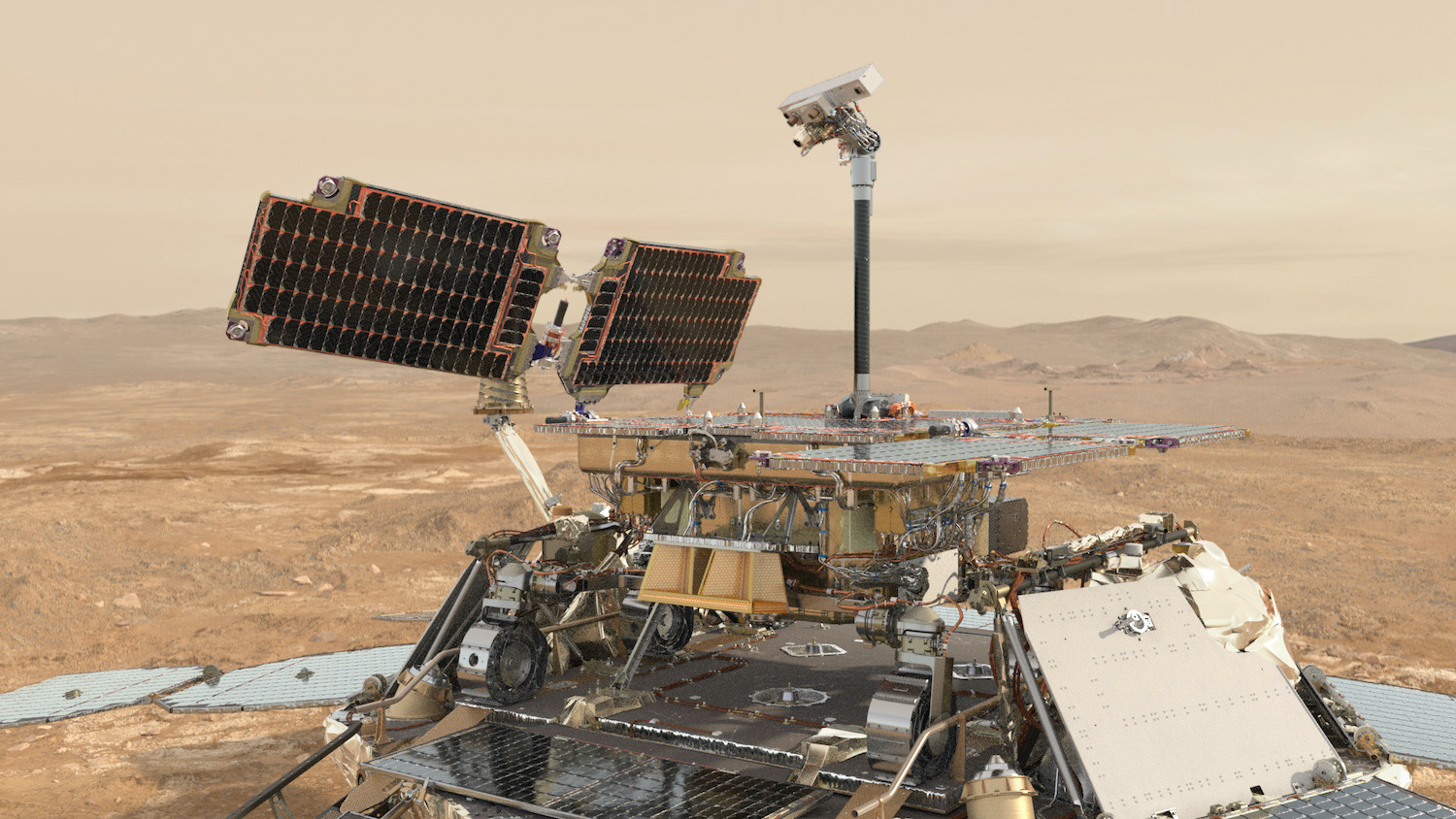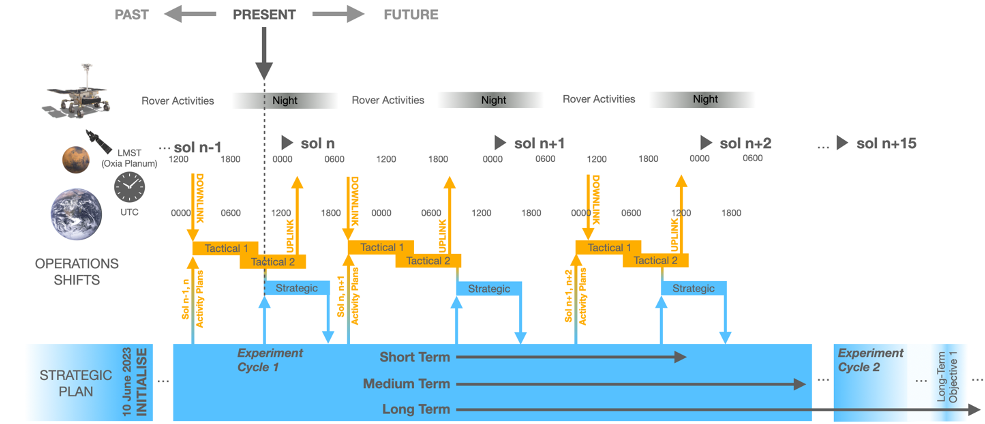The ExoMars Rosalind Franklin Rover: Continuing Mission Preparations
- 1European Space Research and Technology Centre (ESTEC) European Space Agency, Noordwijk, The Netherlands (elliot.sefton-nash@esa.int)
- 2European Space Operations Centre (ESOC), Darmstadt, Germany
- 3European Space Astronomy Centre (ESAC), Villanueva de la Cañada, Madrid, Spain
Introduction
Studies are underway to provide solutions to bring the Rosalind Franklin rover to Mars (Figure 1). Complementing the ExoMars 2016 mission involving the Trace Gas Orbiter and Schiaparelli spacecraft [1, 2], the second ExoMars mission’s science objectives are to search for signs of past and present life, and to investigate the subsurface water/geochemical environment as a function of depth [3, 4].
We report on work by the Science Team to finalise preparations that would have been needed for a launch in 2022, and that remain essential for readiness at a future launch date.

Figure 1.
Rover Science Operations Working Group (RSOWG)
The ExoMars RSOWG was chartered in 2019 to advance the state of preparation for Rover science operations within the science team. Sub-groups are tasked with addressing specific needs:
RSOWG-Micro address topics regarding the spatial scale of the samples that will be extracted from down to 2m by the rover’s drill, their analogues, and plans for their analyses. Notable recent work by the Micro sub-group has included (i) Recommending a sequence of rover activities following commissioning, named ‘Science.0’. The goal of the Science.0 activities is to prime the rover’s analytical laboratory and characterise its initial state prior to commencing analysis to search for biosignatures on Mars samples. (ii) Running a process to propose, select and analyse a set of ‘Mission Reference Samples’ – a suite of analogue samples most relevant to the landing site and mission objectives to be characterized by ground models of the MicrOmega [5], RLS [6] and MOMA [7] instruments.
RSOWG-Macro address topics using the wealth of remote sensing data amassed by orbiter missions, and at rover to regional spatial scales. In 2020-2021 the Macro group performed a group mapping exercise of the Oxia Planum landing site [8] to develop understanding of the site’s stratigraphy and geological history [9]. A related output has been the publication of a corresponding Geographic Framework [10], to be used during simulations and operations. Other RSOWG-Macro activities have included defining how to initialise the mission’s ‘Strategic Plan’ upon landing, building a version-controlled repository of orbital data products, and establishing conventions for naming features and places at the landing site.
The RSOWG Simulations Planning Group comprises a team of ‘Simulation Officers’, nominated from Pasteur Payload Teams, ESA and industry. In 2021 they were tasked with designing and leading a series of ‘RSOWG Simulations’, an early series of team simulations that were intended to rehearse and refine strategic science processes. Scenarios, entitled ‘After Landing’, ‘Site Survey’, ‘Opportunistic science trade-off’ and ‘ALD Analyses’, required science data interpretation, rover activity planning, and decision making at strategic level, and used data from all 9 Pasteur Payload instruments. Lessons learned from early simulations, inform planning of future simulations and exercises, including those prepared by the Rover Operations Control Centre (ROCC – Turin, Italy) for training and certification of team members for operations.
During 2022 and beyond, RSOWG are focussing on maturing the mission’s ‘Strategic Plan’, which provides traceability from the Rover mission science objectives to individual rover and instrument activities, taking into account the realities of the landing site. The RSOWG is tasked to form the Strategic Plan by 1) identifying questions that stem from the Rover mission science objectives and organizing them into scientific priorities, 2) defining hypotheses that should be tested using rover instruments, and 3) identifying targets and ‘skeleton’ plans of activities that could be performed by the rover and its instruments that would address specific groups of hypotheses.
Plans, People, and Processes
Some aspects of science operations preparations lie outside the responsibility of RSOWG, and are complementary to the industry-led development and testing of systems and rover operations at the ROCC.
The ‘Science Operations Plan’ was developed to ensure that daily science operations processes in Tactical and Strategic planning cycles (Figure 2) are complete, robust, transparent, efficient, and collegiate. The plan complements ground and flight control procedures, and covers science team organization, communication, journaling, science-specific tools, and designated roles.

Figure 2: Illustration of Tactical planning (synchronized with orbiter overflights) and Strategic Planning (office hours) shifts as they relate to UTC and Local Mean Solar Time at Oxia Planum. The 'Strategic Plan' guides and governs the decisions made during planning cycles.
The rover long-term data archive, hosted on the ESA Planetary Science Archive (PSA) [11], will contain not only data from science instruments in the Pasteur Payload, but also data regarding the Rosalind Franklin rover’s journey through Oxia Planum. This is achieved via the ‘Science Target Scheme’, which prescribes data structures and links between them for a hierarchy of target classes from landing site to sample analysis scales.
The Sample Analysis Protocol (SAP), in preparation, builds on the ExoMars Biosignature Score (EBS) [3], and is intended define the investigations and metrics for establishing and reporting whether a location on Mars has hosted microbial life, past or present.
Finally, analyses and bespoke tools support needs in areas such as staffing, sequence optimisation for rover activities, and ‘trade-sheets’ [12] to aid decision-making for science targets.
Acknowledgments
We thank the ExoMars Pasteur Payload, Science, and Industrial Teams, for their profound continuing efforts to prepare the first European Mars rover mission that will search for signs of life on Mars.
References
[1] Vago, J. L. et al., (2015) Sol. Syst. Res. 49 (7), 518–528.
[2] Svedhem, H. et al., (2020) 14th Eur. Sci. Congr. 2020, held virtually, 21 Sept. 2020 - 9 October, 2020. Abs. EPSC2020-802.
[3] Vago, J. L. et al., (2017) Astrobiology 17 (6–7), 471–510.
[4] Thomas, N. et al., (2017) Space Sci. Rev. 212 (3–4), 1897–1944.
[5] Bibring, J.-P. et al., (2017) Astrobiology 17 (6–7), 621–626.
[6] Rull, F. et al., (2017) Astrobiology 17 (6–7), 627–654.
[7] Goesmann, F. et al., (2017) Astrobiology 17 (6–7), 655–685.
[8] Sefton-Nash, E. et al., (2021) in 52nd Lunar Planet. Sci. Conf.
[9] P. Fawdon, et al. (2022) in Lunar Planet. Sci. Conf., LPI.
[10] Fawdon, P. et al., (2021) J. Maps 17 (2), 762–778.
[11] Lim, T.-L. et al., (2021) in 5th Planet. Data Work. Planet. Sci. Informatics Anal., Vol. 2549.
[12] Torres, I. et al., (2022) '“Trade-Off” Tools to Quantify Biosignature Potentials for Future ExoMars Rover Mission Operations', This Conference.
How to cite: Sefton-Nash, E., Vago, J. L., Torres, I., Fonteyne, R., Orgel, C., Bahia, R., Joudrier, L., Haessig, F., Williams, A., Guerbuez, C., Lim, T., Ball, A. J., and Mitschdoerfer, P.: The ExoMars Rosalind Franklin Rover: Continuing Mission Preparations, Europlanet Science Congress 2022, Granada, Spain, 18–23 Sep 2022, EPSC2022-800, https://doi.org/10.5194/epsc2022-800, 2022.

